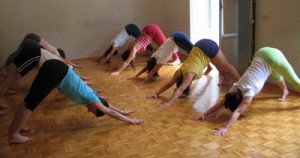 As a teacher of yoga and Pilates, I am aware that some people stick with either one method or the other as part of their exercise program. Even in our modern era of fitness, where crossover classes such as Yogilates are the latest rage, some choose to be loyal to their preferred modality.
As a teacher of yoga and Pilates, I am aware that some people stick with either one method or the other as part of their exercise program. Even in our modern era of fitness, where crossover classes such as Yogilates are the latest rage, some choose to be loyal to their preferred modality.
While there are many similarities between yoga and Pilates, the differences that exist may be enough to tip the scale of favoritism.
What is Yoga?
Yoga is a 5000-year-old discipline steeped in spirituality. The practice of yoga- however diluted by modern culture- still involves a whisper of self-reflection and divine connection. Good for the mind and the body, yoga rises above the realm of exercise because of its intention to elevate the consciousness of those who practice.
What is Pilates?
Pilates is a method of exercise developed by Joseph Pilates in the early twentieth century as a means to “heal the body”. By integrating the mind and body by what is referred to as “contrology,” participants learn to strengthen the muscles of their core. The core is essentially referred to as the space between the hips and the ribs. Pilates exercises are designed to target this area (the powerhouse) for the purpose of what Joseph Pilates believed, creates a long, lean and integrated human body.
While both support the essence of mind-body connection, yoga carries a lot more history, with its spiritually based mores and traditions.
What is the cost?
Aside from using yoga blocks, straps and bolsters for support, “the most important pieces of equipment you need to practice yoga are your mind and body,” explains yoga master Rodney Yee.
For obvious reasons, when all you need is your mind and your body to practice yoga, there is no need to bust out your wallet. But, to take a class is a different story.
With a yoga studio on nearly every corner, and enough people to support them, the business of yoga is prolific. I’ve seen classes listed as high as $22 for a drop in fee, with lower priced options for buying punch cards or monthly packages.
While it is also possible to practice Pilates with no equipment (Mat class), other options include using the Pilates Reformer, Pilates Cadillac, Pilates Chair, Pilates Barrel, Pilates Circle, Pilates Spine Corrector, Pilates Ped-o-pull and several others.
Privates or semi-private classes that incorporate the use of the Reformer or Cadillac can cost from $30 to $150 per visit. Mat classes at exclusive Pilates studios are similar in price to taking a yoga class.
Both yoga and Pilates Mat classes are likely offered in your local gym or health club, and can sometimes be included in the cost of your club membership.
Ease of Use
I am often asked which is easier of the two. Both can be equally challenging, and take a while to master. While flexibility is not necessary to practice either, a keen awareness of the mind-body connection is essential for both. Yoga postures are often very dynamic and can be somewhat complex. Pilates exercises are relatively simple, but demand precise awareness of the core muscle groups to be effective.
There are dozens of styles of yoga that range from gentle to vigorous, offering something for everyone.
Yoga classes appropriate for the beginner include Hatha, Yoga Basics and Intro to Yoga. Ashtanga and Vinyasa flow classes for example, are generally geared toward those of an average or greater level of fitness.
Mat classes are usually categorized Level 1-3 to allow for the progression from beginner to advanced. Since the Pilates method is based on a sequence of exercises that prepare the body for deeper core integration, starting at level 1 is common and expected.
Ease of Accessibility
As mentioned earlier, yoga studios continue to pop up everywhere. It is likely, even in a small, rural community, that someone is offering a yoga class.
Pilates studios however are not as common, and finding one that uses the Reformer or Cadillac may be harder to locate. The good news is that your local health club is likely to have Mat classes scheduled frequently throughout the day.
I find that the core work of Pilates compliments my soul-searching, hamstring stretching endeavors of yoga. Which do you prefer?
Also Read:


